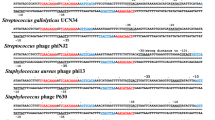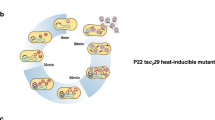Abstract
INTEREST in bacteriophage Mu stems from the highly promiscuous insertion of its DNA into the genome of its host bacterium Escherichia coli (see ref. 1 for review). There are two characterstic features of Mu DNA: first, mature Mu DNA contains heterogeneous host sequences at both ends2,3, and second, near the right end, the S end, of Mu DNA there is a 3,000 base pair sequence that can undergo inversion. The structure of Mu DNA is diagrammed in Fig. 1. The invertible sequence, called the G segment, is remarkable in that it is also found in bacteriophage P1 (ref. 4). The inversion of the G segment in Mu occurs in the prophage state and is independent of the recA function of the host5. According to Hsu and Davidson6, the inversion occurs by recombination between identical but inverted sequences of about 50 base pairs flanking the G segment. Allet and Bukhari7 have presented evidence that a Mu function, located within or close to the G segment, is required for the inversion reaction. When Mu particles are grown by induction of a lysogen, about half of the particles contain DNA with one orientation (referred to as the + or flip orientation) and the rest of the particles have the G segment in the reverse orientation (the − or flop orientation). However, when Mu particles are grown by infection, almost all of the particles contain DNA with the flip orientation. The predominance of the flip orientation is obtained even if the phage lysate used for infection contained equal numbers of the flip and the flop orientations. We show here that the predominance of the flip orientation after infection results from the inability of the flop containing particles to adsorb properly to the bacterial cells.
This is a preview of subscription content, access via your institution
Access options
Subscribe to this journal
Receive 51 print issues and online access
$199.00 per year
only $3.90 per issue
Buy this article
- Purchase on Springer Link
- Instant access to full article PDF
Prices may be subject to local taxes which are calculated during checkout
Similar content being viewed by others
References
Bukhari, A. I. A. Rev. Genetics 10, 389–412 (1976).
Daniell, E., Abelson, J., Kim, J. S. & Davidson, N. Virology 51, 237–239 (1973).
Bukhari, A. I., Froshauer, S. & Botchan, M. Nature 264, 580–583 (1976).
Chow, L. & Bukhari, A. I. Virology 74, 242–248 (1976).
Hsu, M. T. & Davidson, N. Proc. natn. Acad. Sci. U.S.A. 69, 2823–2827 (1972).
Hsu, M. T. & Davidson, N. Virology 58, 229–230 (1974).
Allet, B. & Bukhari, A. I. J. molec. Biol. 92, 529–540 (1975).
Chow, L., Kamp, D. & Kahmann, R. in DNA Insertion Elements, Plasmids and Episomes (eds Bukhari, A. I., Shapiro, J. & Adhya, S.) 307–314 (1977).
Kamp, D., Kahmann, R., Zipser, D., Broker, T. & Chow, L. Nature 271, 577–580 (1978).
Kahmann, R., Kamp, D. & Zipser, D. in DNA Insertion Elements, Plasmids and Episomes (eds Bukhari, A. I., Shapiro, J. & Adhya, S.) 335–339 (1977).
Bukhari, A. I. & Ljungquist, E. in DNA Insertion Elements, Plasmids and Episomes (eds Bukhari, A. I., Shapiro, J. & Adhya, S.) 749–756 (1977).
Southern, E. M. J. molec. Biol. 98, 503–517 (1975).
Ljungquist, E. & Bukhari, A. I. Proc. natn. Acad. Sci. U.S.A. 74, 3143–3147 (1977).
Symonds, N. & Coelho, A. Nature 271, 573–574 (1978).
Zieg, J., Silverman, M., Hilmen, M. & Simon, M. Science 196, 170–172 (1977).
Author information
Authors and Affiliations
Rights and permissions
About this article
Cite this article
BUKHARI, A., AMBROSIO, L. The invertible segment of bacteriophage Mu DNA determines the adsorption properties of Mu particles. Nature 271, 575–577 (1978). https://doi.org/10.1038/271575a0
Received:
Accepted:
Published:
Issue Date:
DOI: https://doi.org/10.1038/271575a0
This article is cited by
-
Chloroplast DNA exists in two orientations
Nature (1983)
-
G inversion in bacteriophage Mu: a novel way of gene splicing
Nature (1982)
-
Instability at the y-1 locus of Chlamydomonas reinhardtii
Molecular and General Genetics MGG (1982)
-
The relationship of two invertible segments in bacteriophage Mu and Salmonella typhimurium DNA
Molecular and General Genetics MGG (1981)
-
A trans-acting factor mediates inversion of a specific DNA segment in flagellar phase variation of Salmonella
Nature (1980)
Comments
By submitting a comment you agree to abide by our Terms and Community Guidelines. If you find something abusive or that does not comply with our terms or guidelines please flag it as inappropriate.



